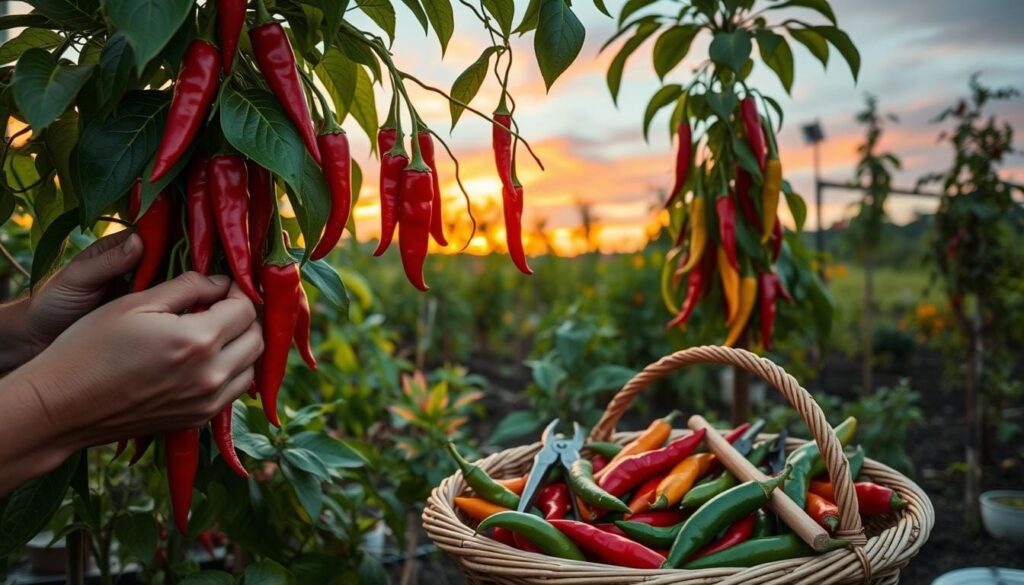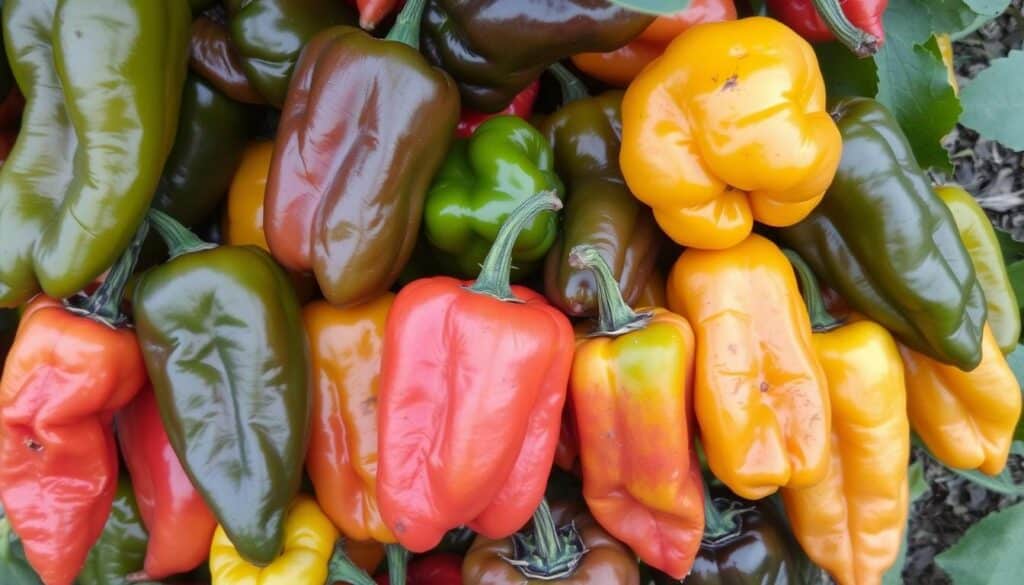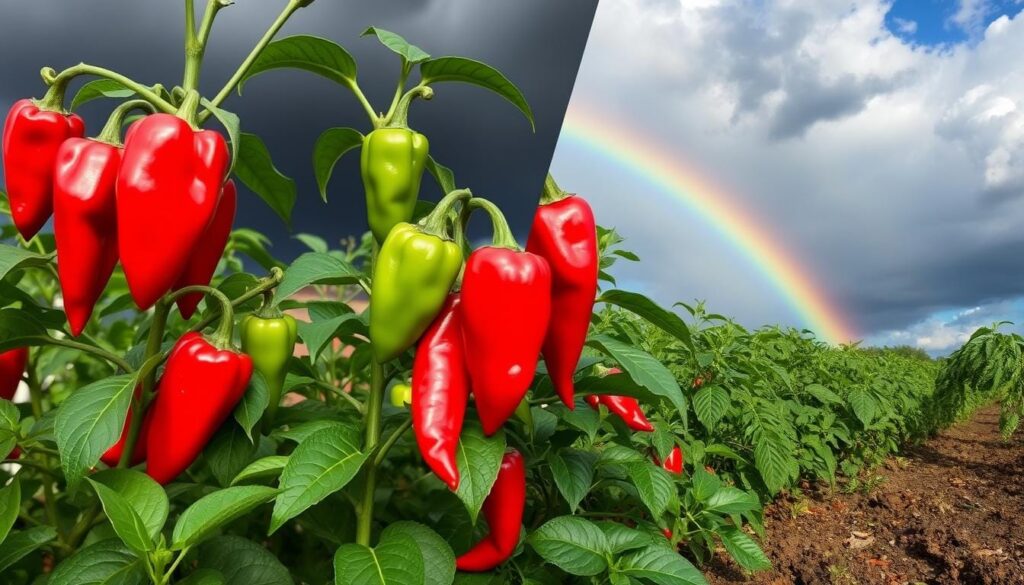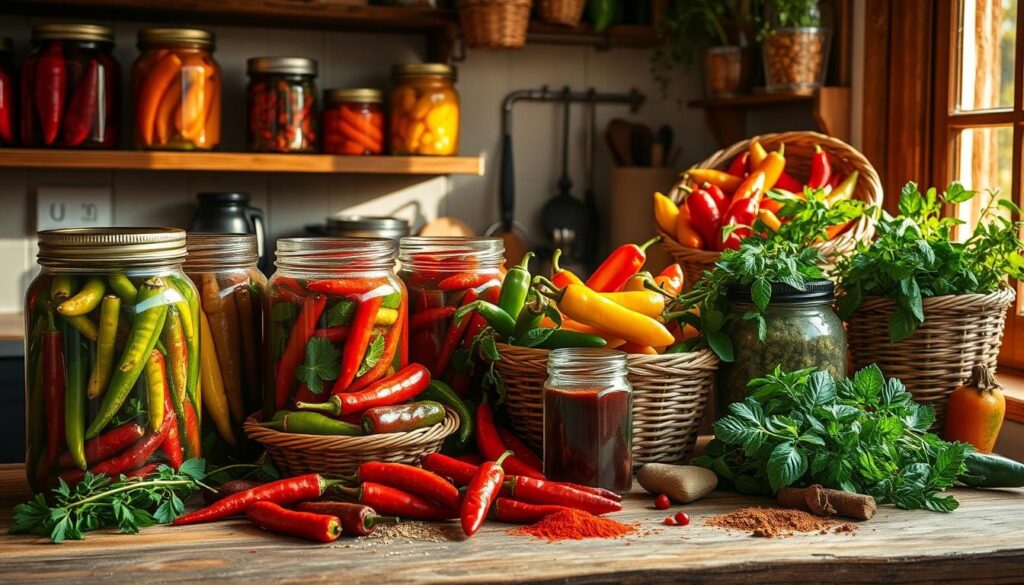When I first saw the vibrant chili peppers in my family’s garden, I knew something special was happening. Growing peppers is more than just a task; it’s a way to connect with the earth’s wonders.
Harvesting chili peppers needs care and patience. We learn that timing is key. Peppers usually take 75-90 days to grow, each type bringing its own taste and look.
Learning to harvest chili peppers means understanding the fine line between ripeness, heat, and flavor. Whether you’re experienced or new to growing peppers, knowing when and how to pick them can change your cooking.
Key Takeaways
- Harvest timing directly impacts pepper heat and flavor intensity
- Different pepper varieties require unique harvesting approaches
- Peak ripeness occurs between 40-50 days after fructification
- Lower pepper plant sections typically produce hotter peppers
- Proper harvesting preserves nutritional value and taste
Understanding the Chili Pepper Life Cycle
Pepper farming needs a deep understanding of the chili pepper’s growth. Knowing each stage and the signs of ripeness is key for a successful harvest.
Chili peppers go through a remarkable journey from seed to fruit. Each phase affects the spicy crop yield. Let’s dive into the amazing transformation of these plants.
The Growth Stages of Chili Peppers
The journey of chili peppers starts with several important phases:
- Germination: Seeds sprout in 7-14 days at 20-30°C
- Seedling Stage: Young plants grow for 2-4 weeks
- Vegetative Growth: Plants grow strong for 4-8 weeks
- Flowering: Blossoms appear in 2-4 weeks
- Fruit Production: Peppers start forming 4-6 weeks after flowers
Signs of Ripeness
Finding the right time to harvest is key in pepper farming. We look for certain signs that tell us when to pick:
| Ripeness Indicator | Description |
|---|---|
| Color Change | Peppers turn from green to bright red, yellow, or orange |
| Size and Firmness | Peppers are fully grown and slightly soft when pressed |
| Skin Texture | Peppers have a smooth, glossy skin with few blemishes |
“Patience in chili pepper cultivation rewards farmers with exceptional flavor and heat intensity.”
The time from seed to harvest is 70-120 days. This depends on the variety and growing conditions. Our careful watch ensures we pick each pepper at its best.
Ideal Harvesting Time
The pepper picking season is key for capsicum annuum harvest. Timing affects the quality and flavor of your chili peppers. Knowing when to harvest can improve your pepper growing experience.
Seasonal Considerations for Pepper Harvesting
Our pepper harvest depends on several seasonal factors. The best time is usually from mid-August to early October, for zone 5 gardens. Each pepper variety matures at a different time:
- Sweet peppers: 70-85 days to full color
- Jalapenos: 70 days (green), 90 days (red)
- Habaneros: 90-100 days to full ripeness
- Serrano peppers: 55-65 days (green), 75-85 days (red)
Optimal Time of Day for Harvesting
Choosing the right time of day is important for pepper quality. We suggest harvesting in the morning. This is after the dew has dried but before the heat of the day. This ensures:
- Maximum moisture retention
- Minimal stress on the plants
- Peak flavor preservation
*”The morning harvest is a delicate dance between moisture and sunlight”* – Pepper Cultivation Expert
| Pepper Type | Green Harvest | Fully Ripe Harvest |
|---|---|---|
| Bell Peppers | Mid-July (Greenhouse) | 90-100 Days |
| Poblano | 65 Days | 85 Days |
| Cayenne | Green Stage | 75 Days (Red) |
Temperature is also important. Peppers grow best between 25-28°C (77-82°F). Growth slows below 17°C (63°F). Avoid harvesting in frost or extreme heat to keep your crop quality high.
Tools We Need for Harvesting
Harvesting chili pods needs careful planning and the right tools. The success of our pepper crop depends on choosing the right tools and safety gear. It’s more than just going to the garden with nothing.
To prepare for a successful harvest, we need to know the essential tools and safety steps. Let’s look at what you’ll need to make your chili pepper collection safe and efficient.
Essential Harvesting Tools
- Sharp garden scissors or pruning shears
- Lightweight collection basket or container
- Mini snips for precision cutting
- Clean, sanitized cutting tools
Safety Equipment for Pepper Harvesting
When working with chili peppers, safety is key. The oils in peppers can irritate skin and eyes, more so with hot varieties.
- Thick rubber gloves (recommended for hot pepper varieties)
- Safety glasses or protective eyewear
- Long-sleeved shirt
- N95 or KN95 mask for processing super-hot peppers
“Proper protection is the key to a safe and enjoyable pepper harvesting experience.”
For hot peppers like habaneros or Carolina Reapers, extra care is needed. The smaller the chile, the more concentrated its heat. Always put your safety first when harvesting chili pods.
Tool Maintenance Tips
- Keep cutting tools clean and sharp
- Sanitize tools between different pepper plant sections
- Store tools in a dry, protected area
- Invest in quality gardening tools for longevity
With the right tools and safety gear, you’ll have a smooth and safe harvest. Remember, preparation is the first step to a successful harvest!
How to Harvest Chili Peppers
Growing peppers needs careful attention, mainly during harvesting. Our guide will show you the best ways to pick your chili peppers. This keeps your plants healthy and boosts your yield.

When you pick chili peppers, being precise is key. The method you choose can affect your plant’s health and the pepper’s quality.
Manual Harvesting Techniques
Successful chili pepper harvesting involves several key strategies:
- Use clean, sharp tools to prevent plant damage
- Cut peppers carefully from the stem
- Leave a small stem attached to protect the fruit
- Avoid pulling peppers directly off the plant
Scissors vs. Hand Picking
We suggest using sharp garden scissors for picking chili peppers. Here’s a comparison:
| Method | Pros | Cons |
|---|---|---|
| Scissors | Precise cut, minimal plant damage | Requires additional tool |
| Hand Picking | Quick, no tools needed | Risk of plant stress and damage |
“Careful harvesting ensures continued pepper production and plant health.” – Pepper Growing Experts
When harvesting chili peppers, timing is key. Different varieties ripen at different times. For example, Jalapeño and Serrano peppers can be picked green. But other varieties need to fully color before picking.
Remember, gentle handling keeps the pepper’s quality high. It also prevents stress on your plants. By following these tips, you’ll get a rich and tasty harvest.
Post-Harvest Handling
After you’ve harvested your chili peppers, it’s important to handle them right. This keeps their quality and taste fresh. Our knowledge shows that good care after picking can make your peppers last longer.
Handling your chili peppers with care is key to keeping them fresh. They quickly spoil if not stored right. Moisture and temperature are very important for keeping them fresh.
Cleaning Your Freshly Harvested Peppers
Cleaning your chili peppers needs to be gentle. Here’s how to do it:
- Avoid washing peppers immediately after picking
- Gently brush off any visible dirt with a soft brush
- Remove any damaged or bruised peppers
Optimal Storage Techniques
Storing your chili peppers correctly is vital. Here’s what we suggest:
| Storage Parameter | Recommended Condition |
|---|---|
| Temperature | 45-50°F (7-10°C) |
| Humidity | 90-95% |
| Storage Container | Clear plastic bag in refrigerator crisper |
| Expected Shelf Life | 2-3 weeks |
*Pro Tip: Always handle your chili peppers with care to prevent mechanical damage that can accelerate quality loss.*
By using these exact steps for post-harvest care, we can keep our chili peppers fresh and tasty. Good storage keeps their nutrients and helps avoid waste in our growing efforts.
Determining Pepper Types
In our pepper farming journey, it’s key to know the world of chili peppers well. Each pepper variety needs its own way of harvesting. Knowing their traits is vital for growing them successfully.
Peppers fall into two main groups: hot and sweet chili peppers. Each group has its own special traits. These traits affect how we harvest and when we pick them.
Hot Pepper Varieties
Hot peppers need careful handling when we harvest them. Our studies show interesting facts about their growth:
- Jalapeños: Best harvested at 3 inches long, deep green color
- Habaneros: Typically 1-2.5 inches long when mature
- Cayenne peppers: Reach about 6 inches in length
- Serrano peppers: Can be harvested green or fully ripened
Sweet Pepper Characteristics
Sweet peppers, like bell peppers, have their own growth rules. They grow to full size at 3.5 to 4 inches. They’re ready when they’re firm and fully grown.
| Pepper Type | Harvest Length | Typical Maturation Days | Color Changes |
|---|---|---|---|
| Bell Peppers | 3.5-4 inches | 70-85 days | Green to red/yellow |
| Banana Peppers | 6-8 inches | 75-90 days | Yellow to red |
| Poblano Peppers | 4 inches | 80-100 days | Green to dark red |
Pro tip for pepper farming: Peppers will easily pull off the plant when fully grown. If they resist, they are not ready yet.
“The art of harvesting peppers lies in understanding each variety’s unique growth cycle and characteristics.” – Pepper Cultivation Expert
Best Practices for Maximum Flavor
To get the best flavor from your peppers, you need to be careful and patient. Our guide will show you how to bring out the taste and heat of your capsicum annuum harvest.
Getting great chili pepper flavor is more than just picking them. Each pepper type gets its own special taste as it grows.
Timing and Flavor Intensity
Knowing when to pick your peppers is key for the best taste. Peppers change a lot as they grow:
- Green peppers are less sweet and milder
- Red peppers are sweeter and more intense
- Heat gets stronger as they ripen more
“The secret to great flavor is patience and keen observation.”
Patient Harvesting Techniques
Our research shows important facts about pepper flavor:
| Pepper Variety | Peak Flavor Time | Heat Development |
|---|---|---|
| Jalapeños | 50-60 days after flowering | Increases from green to red |
| Habaneros | 50 days after fructification | Reaches peak heat quickly |
| Pequin Chilis | 40 days after fructification | Rapidly develops intense heat |
Pro tip: Let peppers fully ripen on the plant for the best flavor. Picking too soon can hurt taste and heat.
When you’re harvesting, watch for color and texture changes. Peppers should be firm but a bit soft when they’re ripe. Waiting a bit longer can turn a regular pepper into a burst of flavor.
Signs of Overripe Peppers
When harvesting chili pods, it’s key to spot overripe peppers to keep quality high. Our guide will show you how to tell if peppers are past their prime. You’ll also learn about their uses.
Color and Texture Indicators
For pepper gathering, watch for visual and physical signs. Overripe peppers show clear signs:
- Color changes from bright to deep orange or red
- Skin gets wrinkled and less firm
- Soft spots appear on the surface
- Potential bruising and rot signs show up

Effects on Taste and Usage
Even overripe peppers have their uses. Their taste changes, becoming:
- Sweeter with less heat
- Great for cooked dishes
- Good for pickling or preserving
“Not all overripe peppers are destined for the compost – many can be transformed into delicious culinary creations.”
Our strategy for harvesting peppers includes daily checks for the best ripeness. Knowing these signs helps us use our crop fully and cut down on waste.
| Pepper Stage | Color | Texture | Recommended Use |
|---|---|---|---|
| Prime Ripeness | Bright, uniform color | Firm | Fresh consumption |
| Overripe | Deep red/orange | Soft, wrinkled | Cooking, preserving |
Remember: Regular harvesting encourages continued fruit production and helps prevent peppers from becoming overripe.
Common Mistakes to Avoid
Getting a good harvest from chili peppers needs careful attention and avoiding common mistakes. Growing peppers requires precision and knowing the challenges that might affect your garden.
When picking chili peppers, gardeners often make critical mistakes. These mistakes can lower the quality and amount of your crop. Let’s look at the most common errors to avoid:
Timing Your Harvest Incorrectly
Getting the timing right for harvesting is key. Our research shows some important points:
- Planting pepper seeds too early can lead to poor germination
- The best time to plant is 4-6 weeks before the last frost date
- Premature harvesting results in underdeveloped flavors
- Late harvesting can cause peppers to become overripe or begin rotting
Neglecting Plant Health
Keeping your plants healthy is vital for a good pepper crop. Here are some key factors to consider:
- Do soil tests to find out if your soil lacks nutrients
- Keep the soil temperature between 75-85°F for the best results
- Give your plants 6-8 hours of direct sunlight every day
- Space plants 30-36 inches apart to prevent competition for nutrients
“The secret to great peppers lies not just in harvesting, but in nurturing your plants throughout their entire growth cycle.”
By knowing these common mistakes in growing peppers, you can greatly improve your harvest. Paying attention, getting the timing right, and keeping your plants healthy are the secrets to success.
The Role of Weather in Harvesting
Weather is key in growing peppers and harvesting chili peppers. Knowing how weather affects our peppers can greatly improve their taste, heat, and quality.

Influence of Rain and Sunlight
Sunlight is a big deal for pepper growth. Studies show that more sun can make chili peppers hotter. Each pepper type reacts differently to sunlight:
- ‘Pequin-Chilis’ reach peak heat units 40 days after fructification
- ‘Habaneros’ require 50 days to achieve maximum heat
- Moderate climates can help peppers ripen longer
Adapting to Seasonal Changes
To grow peppers well, we must adjust to the seasons. Our harvest plan must consider important factors:
| Weather Factor | Impact on Pepper Harvest |
|---|---|
| Frost | Harvest before first frost to avoid losing crops |
| Rain | Too much rain can make pepper flavors weak |
| Sunlight | Makes peppers hotter and spicier |
“Weather is the unseen artist in pepper cultivation, painting flavors and heat with invisible brushstrokes.”
Harvesting chili peppers needs careful watching of the weather. We suggest keeping an eye on the forecast, protecting plants from harsh weather, and picking peppers at the right time. This way, we can get the best quality and amount of peppers.
Remember, timing is everything in growing peppers. By understanding how weather works, we can make our pepper harvest truly great.
Preparing for the Next Growing Season
After a successful pepper farming season, we must plan carefully for the next one. We need to make sure our chili pepper plants do well. This means we have to think ahead and use smart strategies.
Soil preparation is key for a good pepper garden. We’ve learned that some important steps can really help next year’s harvest.
Essential Soil and Fertilization Strategies
Healthy soil is essential for growing peppers. Here are some tips for preparing the soil:
- Amend soil with aged compost before planting
- Use a well-balanced, slow-release fertilizer
- Maintain soil temperatures above 70°F for optimal growth
- Apply 1-2 inches of mulch for moisture retention
Smart Plant Rotation Techniques
Crop rotation is important for keeping soil healthy and preventing diseases. By rotating our pepper plants, we can:
- Reduce soil-borne disease risks
- Prevent nutrient depletion
- Disrupt pest life cycles
- Improve overall garden ecosystem
“The key to a successful pepper harvest lies not just in the current season, but in thoughtful preparation for the next.” – Experienced Pepper Farmer
Our success in pepper farming depends on these key factors. By using these strategies, we’re ready for a great harvest next season.
Recipes for Leftover Peppers
After a bountiful capsicum annuum harvest, our kitchen turns into a creative space. The pepper picking season brings vibrant colors and endless possibilities. We can enjoy our homegrown chili peppers in many ways.

Creative Culinary Adventures
Our extra peppers lead to exciting recipes and preservation methods. Let’s dive into tasty ways to use our harvest:
- Hot pepper jelly for gourmet appetizers
- Homemade chili-infused oils
- Spicy marinades and dressings
- Red pepper flake condiments
Preservation Techniques
Preserving peppers lets us enjoy our harvest all year. Here are some effective ways:
| Preservation Method | Storage Duration | Best For |
|---|---|---|
| Freezing | Up to 6 months | Whole or chopped peppers |
| Drying | Up to 1 year | Creating spice powders |
| Pickling | 3-4 months | Jalapeños and mild peppers |
Safety and Preparation Tips
When handling hot peppers, safety is key. Always wear gloves and work in a well-ventilated area. This protects us from capsaicin’s intense heat.
“Preservation is an art that transforms our harvest into year-round culinary delights.” – Chili Pepper Enthuasiast
By using these methods, we make our pepper picking season a year-round celebration of flavor and creativity.
Conclusion: Our Harvesting Journey
Our chili pod harvesting adventure has been amazing. We’ve learned a lot about growth, patience, and farming skills. It’s not just about picking peppers. It’s about understanding nature, soil, and how to grow them.
We’ve seen that each growing season brings new challenges and lessons. We’ve tracked germination and learned when to harvest. This journey has taught us to appreciate the complexity of growing chili peppers. Knowledge and practice are key to great results.
Reflecting on Our Experience
Looking back, we see that harvesting chili pods is a skill that grows with time and effort. We’ve learned about the best growing temperatures and how to know when peppers are ripe. These lessons will help us in the future.
Our techniques for gathering peppers have improved, making each harvest more enjoyable. We’re proud of what we’ve learned and how we’ve grown.
Looking Ahead to Future Harvests
We’re looking forward to future growing seasons. We know that each pepper plant has its own story to tell. By using what we’ve learned, gardeners can make growing chili peppers a rewarding experience.
This experience connects us to nature and sustainable food. It’s a journey that we’re excited to continue.

